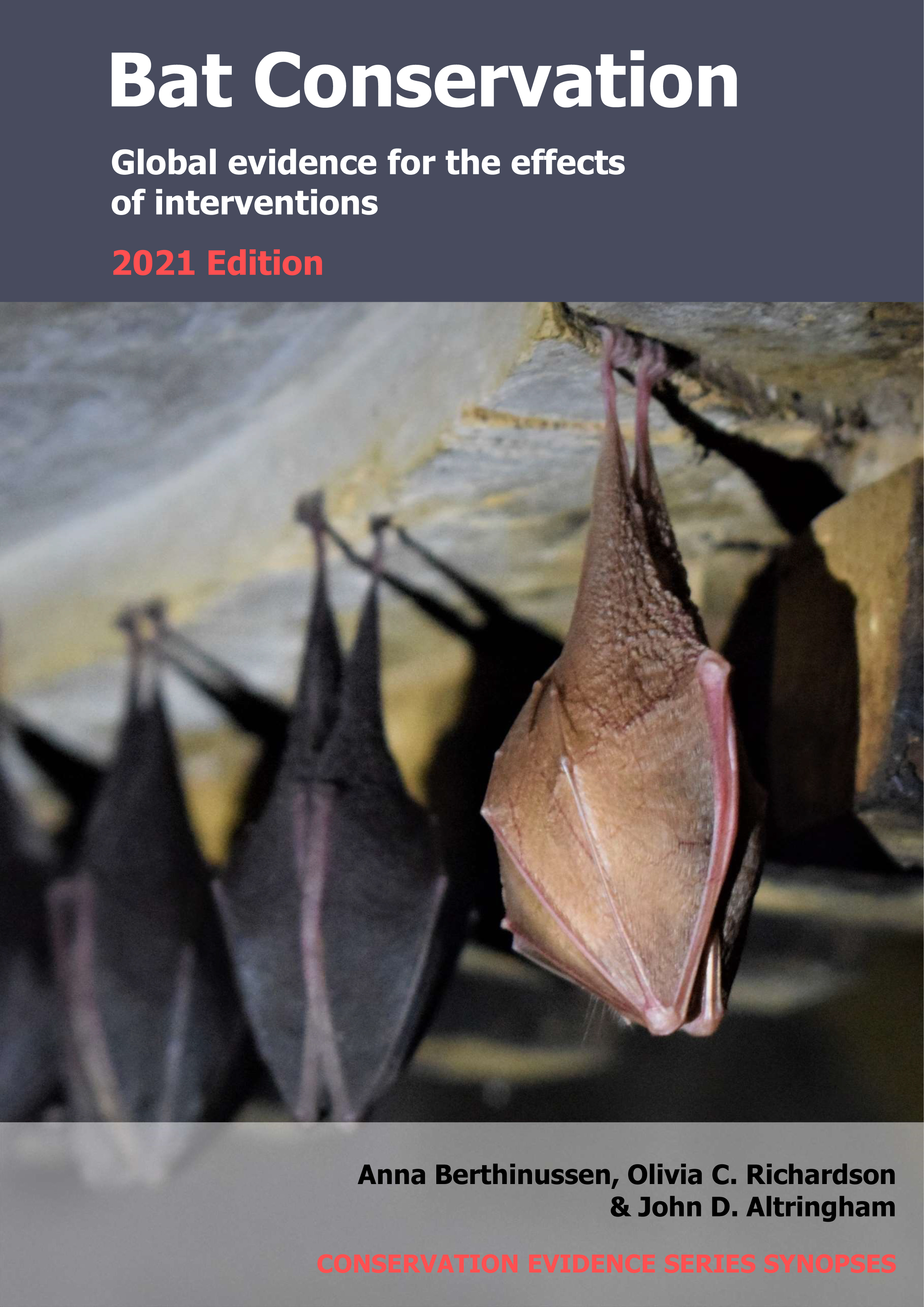Rehabilitate injured/orphaned bats to maintain wild bat populations
-
Overall effectiveness category Unknown effectiveness (limited evidence)
-
Number of studies: 4
View assessment score
Hide assessment score
How is the evidence assessed?
-
Effectiveness
47% -
Certainty
27% -
Harms
0%
Study locations
Supporting evidence from individual studies
A study in 2002–2006 at a wildlife rehabilitaton centre in the UK (Kelly et al 2008) found that five hand-reared Pipistrellus spp. bats released into the wild after prolonged flight training in a large flight cage survived for at least 5–10 nights and were active each night, but seven bats released after a limited amount of flight training or training in a limited space did not survive or were less active after release. Five bats that flew for 21 days in a large flight cage (7 x 4 x 2.3 m) before release were radio-tracked for 5–10 days after their release and were recorded actively flying each night. Two bats that flew in a smaller flight enclosure (3 x 2 x 1.8 m) before release flew well on the first night after release but did not fly on the second and third nights. Five bats that flew for 20 minutes/day in an enclosed room before release were found on the ground within 48 h of release (four bats) or contact was lost with the radio tag (one bat). All of 12 injured or orphaned bats were hand-reared by domestic carers (seven bats) or a wildlife rehabilitation centre (five bats). Bat pups were kept in an incubator and fed a milk substitute. At 3–4 weeks old, they were moved to unheated bat boxes and weaned onto mealworms. Bats were radio-tracked for 1–10 nights following release from their bat boxes at sites close to known bat roosts in 2002, 2005 or 2006.
Study and other actions testedA study in 2006–2007 at a wildlife rehabilitation centre in the UK (Kelly et al 2012) found that seven of 10 hand-reared pipistrelle bats survived for at least 4–10 days after release into the wild, and 13% of released ringed bats returned to bat boxes 38 days to 3.8 years after release. Seven bats (two common pipistrelles Pipistrellus pipistrellus, five soprano pipistrelles Pipistrellus pygmaeus) were radio-tracked for 4–10 days after release before the signal with their radio tags was lost. Three common pipistrelles were taken back into captivity after 1–4 nights after becoming trapped in buildings or unable to fly. Five of 39 (13%) ringed bats were found alive in bat boxes used for release 38 days to 3.8 years after release. All bats were admitted to the centre as juveniles and hand-reared using the same methods as (2). Before release, all bats flew freely in an outdoor flight cage. Thirty-nine bats were fitted with rings and released from bat boxes in 2006–2007. Bat boxes were checked daily for ringed bats in 2006–2007. Ten bats were fitted with radio tags and released from bat boxes in August and September 2007. Radio-tracking was carried out for 1–10 nights following release.
Study and other actions testedA study in 2008–2009 in a rural area of central Italy (Serangeli et al 2012) found that 19 of 21 hand-reared Kuhl’s pipistrelle bats Pipistrellus kuhlii survived for at least 4–14 days after release into the wild, and six joined wild Kuhl’s pipistrelle colonies. Six of the 19 bats joined two wild Kuhl’s pipistrelle colonies roosting in nearby buildings. Another six roosted in buildings previously unoccupied by bats, and seven continued to roost in two bat boxes used for release. Two bats could not be tracked as contact was lost with their radio tags within two days of release. Thirty-seven orphaned newborn bats (18 in 2008, 19 in 2009) were reared in heated boxes and fed powdered milk. At 3–4 weeks old, bats were weaned with mealworms and moved to a flight room (8 x 5 x 3 m) with four bat boxes. After 12 days in the flight room, bats able to fly continuously for ≥10 minutes on one night were selected for release. Twenty-one bats (11 in 2008, 10 in 2009) were fitted with radio tags and released 1 h before sunset in the same region they came from. Two bat boxes from the flight room were hung on trees at the release site. Radio-tracking was carried out over 14 nights after bats were released in 2008 and 2009.
Study and other actions testedA study in 2001–2002 in a research centre in Rio de Janeiro, Brazil (Esberárd et al 2014) found that two hand-reared greater spear-nosed bats Phyllostomus hastatus survived over three months and reached normal body size for the species. Over approximately two months, the body weight of two hand-reared greater spear-nosed bats increased from 21–40 g to 86–97 g. After 60 days, both individuals had reached a body size normal for the species (forearm of 88 mm). Two abandoned greater spear-nosed bats with an estimated age of 15–20 days were taken into captivity in November 2001. Bats were initially fed 1–2 ml of commercial baby formula with a syringe every 2 h. The amount of food was increased by 1–2 ml/week. After the second month, the bats were fed an equal amount of baby formula and avocado for three days and thereafter a mix of fruit (75%), bird food (15%), dog food (5%), egg (2.5%), cow meat (5%) and honey (0.5%).
Study and other actions tested
Where has this evidence come from?
List of journals searched by synopsis
All the journals searched for all synopses
This Action forms part of the Action Synopsis:
Bat Conservation
Bat Conservation - Published 2021
Update 2020





)_2023.JPG)














